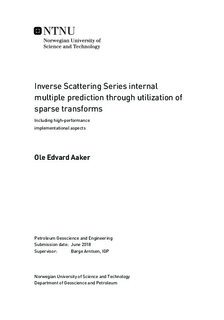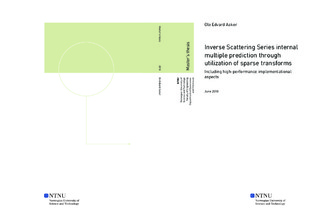| dc.description.abstract | Industry standard imaging algorithms do not treat internal multiples correctly. 'Cross-talk' with primary reflections may therefore occur in the imaging procedure, potentially causing significant artifacts in the image of the subsurface.
The Inverse Scattering Series (abbr. ISS) internal multiple prediction algorithms enable completely data-driven computation of internal multiple models that are kinematically accurate with well-approximated amplitudes. The ISS prediction algorithms are therefore key candidates for computing internal multiple models suitable for use in adaptive subtraction procedures. This thesis work has been centered around implementation of the Inverse Scattering Series predictors in the coupled plane wave domain in 2D, and its 1.5D variant in the plane wave domain.
The prediction codes implemented employ a vast range of optimizations, including algorithmic optimizations and code optimizations, such as vectorization and parallelization. In the case of restricted dips of interfaces related to internal multiple generation the coupled plane wave domain easily facilitates a reduction of the number of required computations.
Linear Radon transforms constitute the mapping of the input data to the coupled plane wave domain. Due to the non-orthogonality of the forward and inverse transform pairs, certain aperture artifacts may arise in the input data after mapping to the prediction domain. Experimental results demonstrated that this may yield some undesired artifacts in the calculated multiple model. It should be noted that, compared to the 2D predictor, the 1.5D prediction algorithm does not appear as sensitive to artifacts present in the plane wave domain.
Motivated by the possibility to minimize artifacts and, in general, to improve the prediction output lead to the implementation of a so-called high-resolution or sparse linear RT. By virtue of its design, where sparseness constraints are imposed in tau-p domain directly, it is effective at both reducing aperture artifacts and as well as compressing the temporal support of the signal.
The usage of high-resolution RTs for transformation to the prediction domain resulted in internal multiple predictions with less artifacts and improved (apparent) waveform matches. Results from adaptive subtraction demonstrated improved internal multiple attenuation, compared to using standard Radon transforms. Automatic regularization routines for the sparse Radon transform can give further benefits, especially for prediction in the coupled plane wave domain.
A previously proposed procedure for enabling multidimensional internal multiple prediction using migrated datasets has been demonstrated with a simple proof of concept. The procedure is considered suitable for application to real data. | en |

